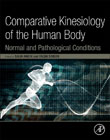
Comparative Kinesiology of the Human Body in Normal and Pathological Conditions
Angin, Salih
Simsek, Ibrahim Engin
Comparative Kinesiology of the Human Body in Normal and Pathological Conditions covers the changes in musculoskeletal, neurological and cardiopulmonary systems, which are the three pillars of human movement. It examines the causes, processes, consequences, and contexts of physical activity from different perspectives and in different life stages including early childhood to elderly. It goes on to further explain how purposeful movement of the human body is affected by pathological conditions related to any of these major systems. Coverage also includes external and internal factors (such as forces and other stresses) that affect the human growth pattern and development, and throughout lifespan (embryo, child, adult and geriatrics). The perfect reference for researchers of kinesiology as well as clinicians and students involved in rehabilitation practice. Explores the three pillars of human activity: the musculoskeletal system as the body segments where and how motion occurs; the neurological system as the sensory-motor control of human movement, and the cardio-pulmonary system as source of energy supply for the moving bodyIncludes in depth coverage of the mechanical behaviour of the embryo as one of the major determinants of human movement throughout the life cycleProvides a comparison of human movement between normal and pathological conditions as well as clinical implications for understanding the underlying mechanisms of the movement disordersSystematically addresses each body region in functional and dysfunctional kinesiological terms INDICE: PART 1: HISTORY AND BASICS OF KINESIOLOGY 1. Past, Present and Future of Kinesiology 2. Principles of Kinesiology 3. Fundamentals of Human movement, Its Control and Energetics PART 2: TISSUES 4. Morphogenesis and Biomechanics of the Embryo 5. Architecture of Bone Tissue and its Adaptation to Pathological Conditions 6. Architecture of Cartilage Tissue and its Adaptation to Pathological Conditions 7. Architecture of Muscle Tissue and its Adaptation to Pathological Conditions 8. Architecture of Tendon and Ligament and their Adaptation to Pathological Conditions 9. Architecture of Fascia and its Adaptation to Pathological Conditions 10. Architecture of Human Joints and their Movement PART 3: UPPER EXTREMITY 11. Kinesiology of the Shoulder Complex 12. Kinesiology of the Elbow Complex 13. Kinesiology of the Wrist and Hand PART 4: TRUNK AND PELVIS 14. Kinesiology of the Temporomandibular Joint 15. Kinesiology of the Cervical Vertebral column 16. Kinesiology of the Thoracic Vertebral Column 17. Kinesiology of the Lumbar Vertebral Column 18. Kinesiology of the Pelvis PART 5: LOWER EXTREMITY 19. Kinesiology of the Hip 20. Kinesiology of the Knee 21. Kinesiology of the Ankle and Foot Complex 22. Kinesiology of Respiration 23. Biomechanics of Circulation PART 6: SENSORY-MOTOR INTEGRATION AND PERFORMANCE 24. Motor Control and Sensory-Motor Integration of Human Movement 25. Motor Learning 26. Balance and Postural Control PART 7: LOCOMOTION 27. Evolution of Bipedalism 28. Kinesiology of Human Gait 29. Effect of Weightlessness on Human Body 30. Biomechanical Principles of the Exercise Design
- ISBN: 978-0-12-812162-7
- Editorial: Academic Press
- Encuadernacion: Rústica
- Páginas: 576
- Fecha Publicación: 19/03/2020
- Nº Volúmenes: 1
- Idioma: Inglés
